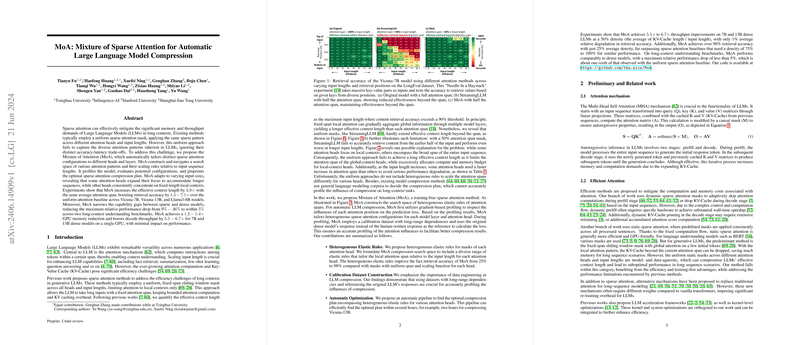Overview of "MoA: Mixture of Sparse Attention for Automatic LLM Compression"
The paper entitled "MoA: Mixture of Sparse Attention for Automatic LLM Compression" introduces a novel approach to tackle the efficiency challenges associated with LLMs when dealing with long sequences. Sparse attention mechanisms historically offer memory and computation relief, but existing methodologies, which typically apply a uniform sparse attention pattern across all attention heads and input lengths, fail to exploit the full potential of LLM architectures. These uniform approaches do not capture the diverse attention patterns necessary for maintaining high performance amidst varying accuracy-latency trade-offs.
Key Contributions
The authors have proposed the Mixture of Attention (MoA), a method designed to automatically calibrate sparse attention configurations uniquely for each attention head and layer within an LLM. The central objectives and contributions of MoA are outlined as follows:
- Heterogeneous Elastic Rules: MoA adopts a non-uniform, context-dependent strategy by implementing heterogeneous elastic rules which adjust sparse attention span dynamically based on the input sequence length. This enables the model to flexibly expand or contract its focus, either maintaining a global perspective or concentrating on local contexts as needed.
- Construction of a Calibration Dataset: The necessity of informing model compression with appropriate datasets is emphasized. The authors leverage data with long-range dependencies, using the model outputs rather than human-generated responses as a reference, to more reliably profile compression effects on LLMs.
- Automatic Optimization Pipeline: MoA employs an automatic pipeline that profiles each attention value's influence and optimizes various configurations to determine the optimal sparse attention pattern for each head. This automatic configuration identifies suitable elastic rules to minimize predictive loss under predefined density constraints.
Results and Implications
The experiments conducted confirm that MoA significantly extends the effective context length of models by up to 3.9 times while improving retrieval accuracy by a factor of 1.5 to 7.1 over uniform sparse baselines. With only a modest degradation in performance metrics, MoA reduces maximum relative performance losses from dense configurations and achieves up to 1.4 times GPU memory savings alongside marked increases in computational throughput (6.6-8.2 times over FlashAttention2).
Theoretical and Practical Implications
The implications of MoA are noteworthy for both performance enhancement and resource optimization. This work showcases that a heterogeneous approach allows LLMs to better allocate attention resources where necessary, mitigating the significant efficiency trade-offs of long-context processing. From a practical standpoint, the methodology offers a transparent and reproducible means to reconfigure LLMs for improved efficiency without the need for significant retraining.
Prospective Developments
In future iterations, exploring non-linear scaling rules and integrating dynamic attention schemes could further optimize context handling across diverse input scenarios. Expanding the profiling concept to evaluate other model components, such as weight matrices, could stimulate advances in complementary compression techniques like quantization or pruning, further broadening the scope of large-model efficiency optimization.
Overall, MoA represents a sophisticated step towards more efficient and versatile LLMs, offering a promising strategy for engaging with the complexity and variability inherent in natural language processing tasks.
